The Baltic States, St. Petersburg, and Moscow
September 26 - October 14, 2013
Part Five - Moscow, Russia
Moscow is the capital city. The city is a major
political,
economic, cultural and scientific center in Russia and in Eurasia.
According to Forbes, Moscow has the largest number of billionaires in the world.
It is the
largest
city in Europe and the 5th largest in the world, with a population of over
11.5 million. It is situated on the Moskva River.Moskva and Moscow are two different
renderings
of the same Russian word Москва. The city is named after the river.
Page One - Arrival in Moscow

Mother and baby at Moscow International Airport
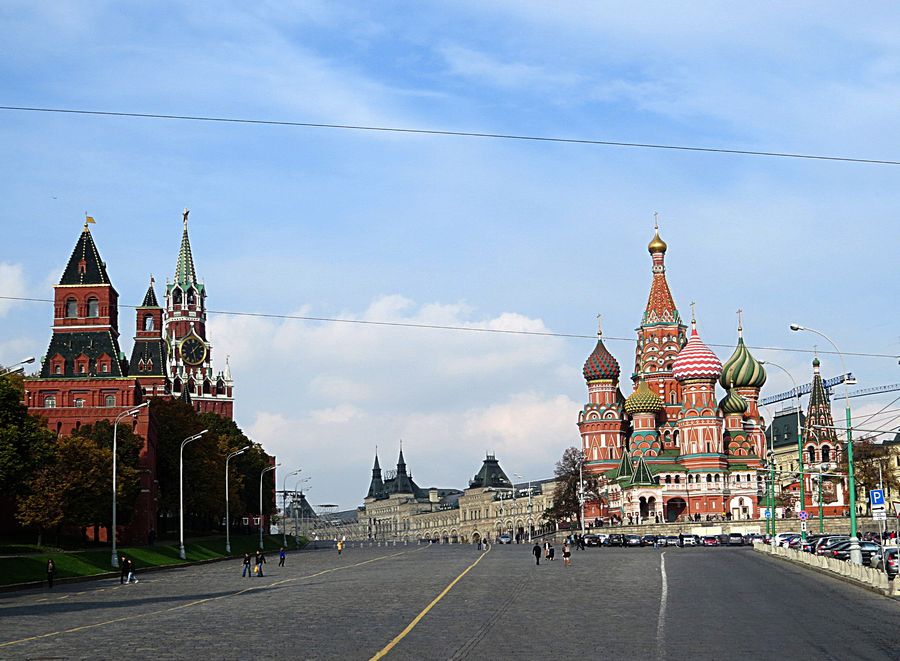
On our way from Moscow Airport to our hotel in Moscow, we drove past
Red Square and the Kremlin. Shown here on the left are some of the
Kremlin Towers that are along the Kremlin Wall, on the right St. Basil's Cathedral,
with GUM Department store in the middle behind the Red Square area.
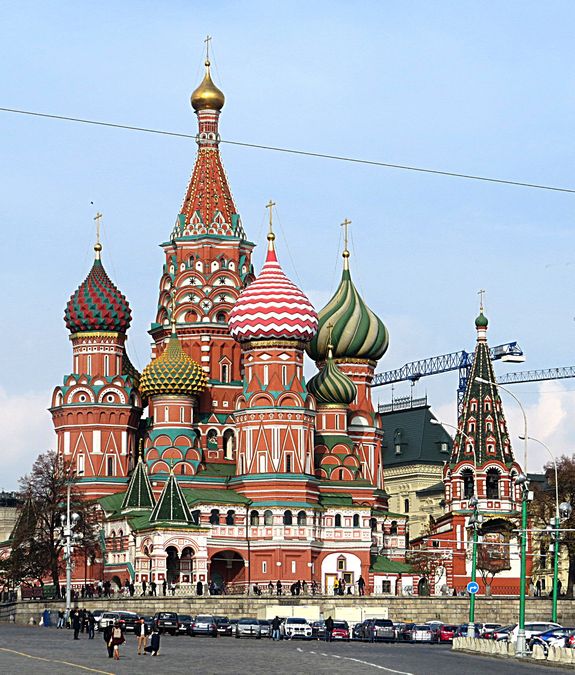
Cathedral of the Intercession or St Basil's Cathedral
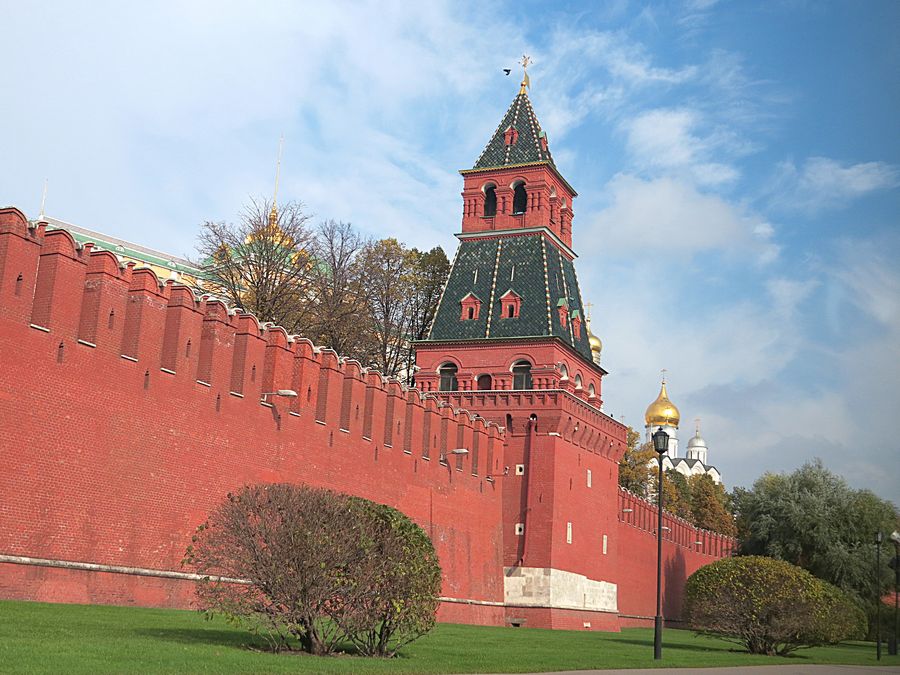
Part of the Kremlin wall. The Kremlin is a historic fortified complex at the
heart of Moscow, overlooking the Moscow River to the south, Saint Basil's
Cathedral and Red Square to the east, and the Alexander Garden to the
west. It is the best known of kremlins (Russian citadels) and includes five
palaces, four cathedrals, and the Kremlin Wall with Kremlin towers. The
complex serves as the official residence of the President of the Russian
Federation.

The Kremlin and Red Square are the ancient heart of Moscow. In addition
to the historical and government sites, this is a lively area with a modern
shopping center.The yellow building is the Great Kremlin Palace.

Former KGB (Secret Police) Headquarters in Lubyanka Square in downtown
Moscow. After the dissolution of the KGB, the Lubyanka became the
headquarters of the Border Guard Service of Russia, and houses the Lubyanka
prison and one directorate of the Federal Security Service of the Russian
Federation. It is a large Neo-Baroque building with a facade of yellow brick
designed in 1897 and augmented from 1940 to 1947. Although the Soviet
secret police changed its name many times, its headquarters remained in
this building. A prison at the ground floor of the building figures
prominently in Aleksandr Solzhenitsyn's classic study of the Soviet police
state, The Gulag Archipelago.
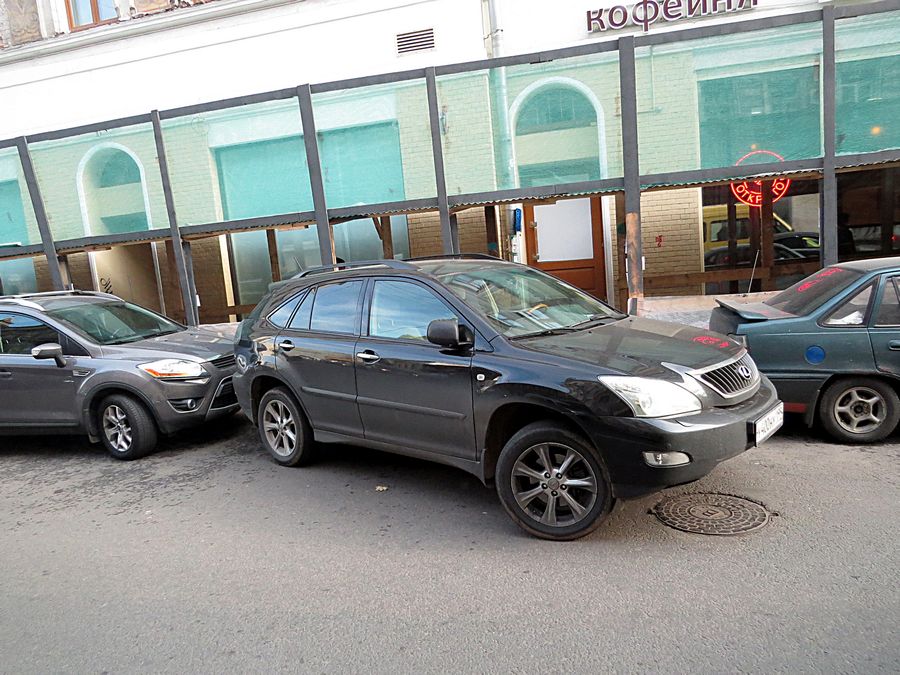
Apparently it is okay to park this way in Moscow.
We saw this kind of parking more than once.

After checking into our hotel and eating lunch, we toured Red Square.
The most prominent structure on the Square is St. Basil's Cathedral,
a Russian Orthodox church. The building is shaped as a flame of a bonfire
rising into the sky, a design that is unusual in Russian architecture.
The cathedral foreshadowed the climax of Russian national architecture
in the 17th century. As part of the program of state atheism, the church
was confiscated from the Russian Orthodox community as part of the
Soviet Union's anti-theist campaigns and has operated as a division of the
State Historical Museum since 1928. It was completely and forcefully
secularized in 1929 and remains a federal property of the Russian Federation.
The church has been part of the Red Square UNESCO World Heritage Site
since 1990.


GUM is the name of the main department store in many cities of the former
Soviet Union, known as State Department Store during the Soviet times.
Similarly named stores were found in some Soviet republics and post-Soviet
states. The most famous GUM is the large store in the part of Moscow facing
Red Square. It is currently a shopping mall. Part of the Moscow GUM is shown
here. It runs along one side of Red Square.

Shoppers and tourists commingling in the Red Square area.

Closeup of church tower shown in previous photo

Kazan Cathedral, also known as the "Cathedral of Our Lady of Kazan," is a
Russian Orthodox church located on the northeast corner of Red Square
in Moscow. The current building is a reconstruction of the original church,
which was destroyed at the direction of then General Secretary of the Central
Committee of the Communist Party of the Soviet Union, Joseph Stalin, in
1936. After the fall of the Soviet Union, the Kazan Cathedral was the first
church to be completely rebuilt after having been destroyed by the
Communists. The cathedral's restoration (1990–1993) was sponsored by
the Moscow city branch of the All-Russian Society for Historic Preservation
and Cultural Organization.
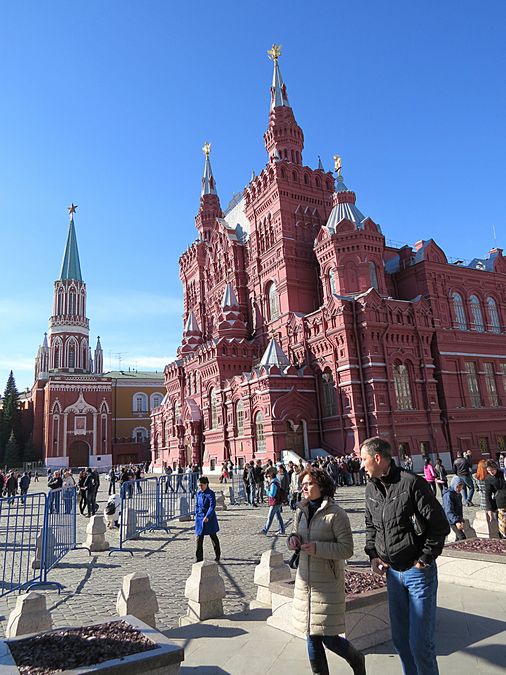
State History Museum on Red Square across from the Kazan Cathedral.
This impressive brick building is a a museum with each room dedicated
to a different historical period.

Resurrection Gate. Although this triumphal arch was built in the early 1990s,
it is an exact replica of the original structure, which stood on this site from
1680 to the early 1930s. Red Square is behind the Gate as is St. Basil's
Cathedral and GUM.
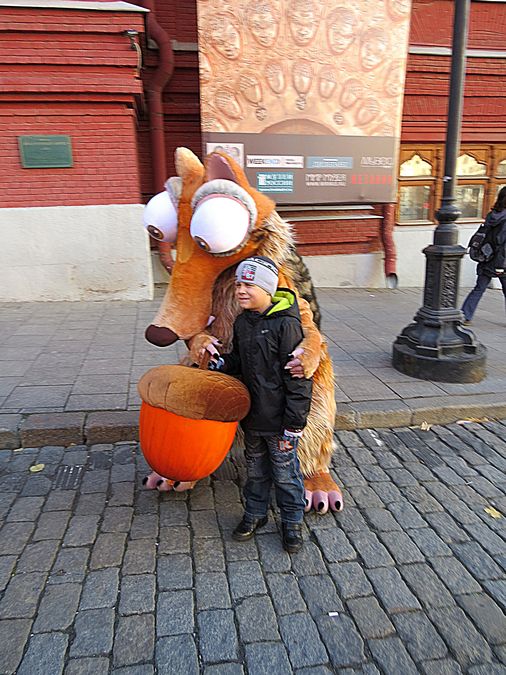
There were a number of young people dressed up in cartoon character outfits in
front of Resurrection Gate. They wanted tips in exchange for having a photo
taken with them.

This character succeeded in having parents taking his/her picture with their
child.

Manezh Square in front of Resurrection Gate. The square is now occupied
by the vast underground shopping mall Okhotny Ryad. Surrounded by
luxury hotels, the square centers on the statue of Marshall Zhukov,
the heroic commander from WWII. The former Central Lenin Museum
provides the backdrop.
It is also the former Moscow City Hall, an ornate
red-brick building situated immediately to the east of the State
Historical Museum and notable in the history of architecture
as a unique hybrid of the Russian Revival and Neo-Renaissance
styles. During Soviet times it served as the Lenin Museum.

This statue near Red Square depicts Marshal of the Soviet Union Georgy
Zhukov, the most decorated general in the history of both Russia and the
Soviet Union. He was a Soviet military commander who, in the course of
World War II, led the Red Army to liberate the Soviet Union from the Axis
Powers' occupation, to advance through much of Eastern Europe, and to
conquer Germany's capital, Berlin.
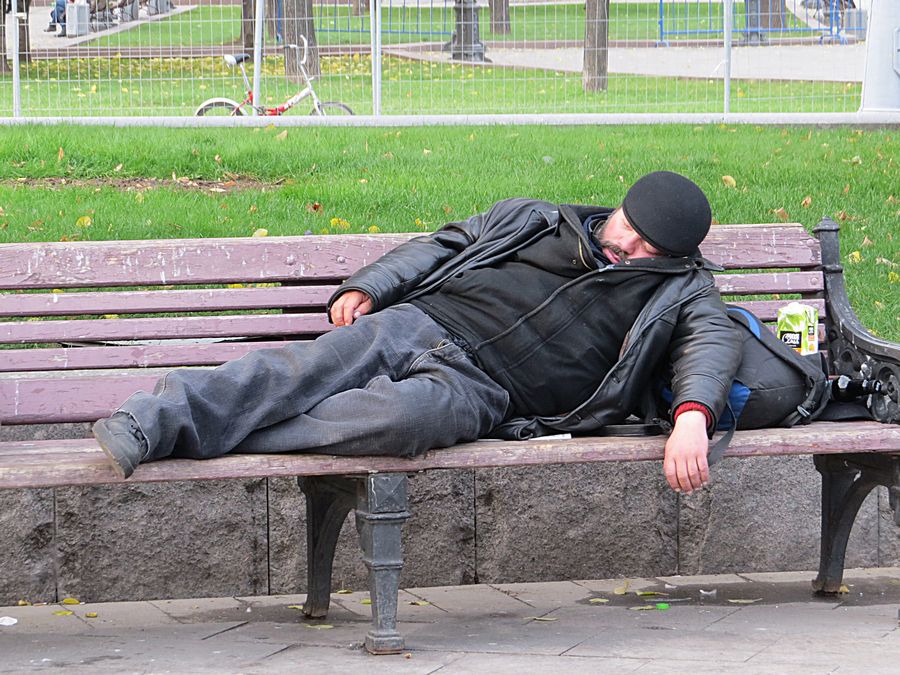
A man sound asleep on a bench in Manezh
Square near Red Square.

Bolshoi Theater is a historic theater in Moscow designed by architect Joseph
Bové, which holds performances of ballet and opera. The theater's original
name was the Imperial Bolshoi Theater of Moscow. At that time, all Russian
theaters were imperial property. Moscow and St. Petersburg each had only
two theaters, one intended for opera and ballet (these were known as the
Bolshoi Theaters), and one for plays (tragedies and comedies). Because
opera and ballet were considered nobler than drama, the opera houses
were named "Grand Theaters" ("Bolshoi" is Russian for "large" or "grand")
and the drama theaters were called the "Smaller Theater" ("Maly" is Russian
for "small" or "lesser"). The main building of the theater, rebuilt and
renovated several times during its history, is a landmark of Moscow
and Russia (its iconic neoclassical facade is depicted on the Russian
100-ruble banknote). On October 28, 2011, the Bolshoi was re-opened
after a six-year renovation.
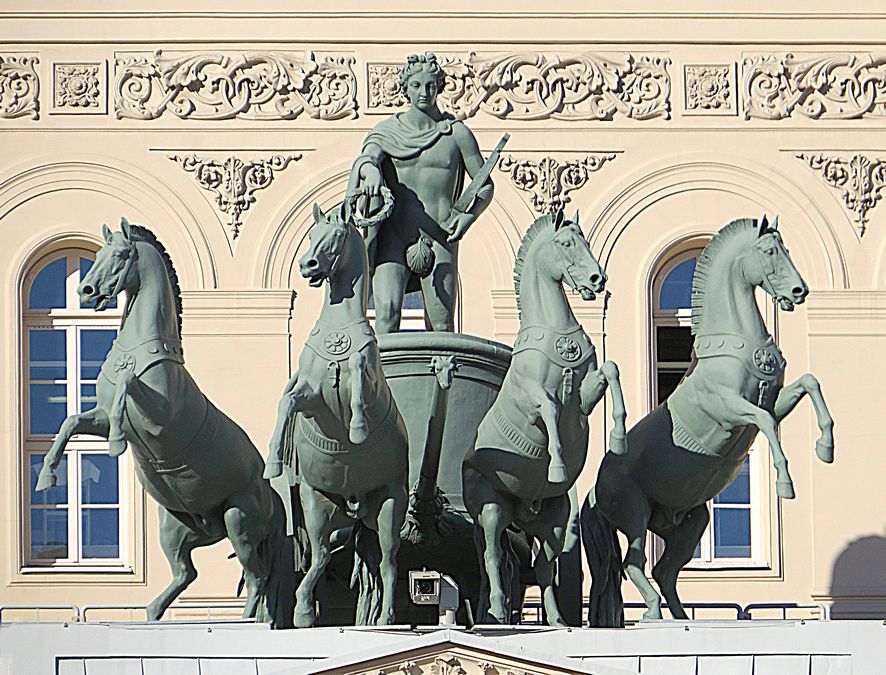
The Bolshoi Ballet and Bolshoi Opera are amongst the oldest and most
renowned ballet and opera companies in the world. It is by far the world's
biggest ballet company, having more than 200 dancers. The theater is the
parent company of The Bolshoi Ballet Academy, a world-famous leading
school of ballet.

In Teatralnaya Square directly across the road from the Bolshoi Theater stands
Moscow's most prominent statue of Karl Marx. The statue was carved on the
spot where it stands from a 200 ton block of granite and was unveiled in 1961.
The inscription on the front translates as "Workers of the world – unite!"

Traffic congestion like this is common in Moscow.
Link to Page Two - Cathedral of Christ the Saviour and Novodevichy Convent area
Link to Part One - Lithuania
Link to Part Two - Latvia
Link to Part Three - Estonia
Link to Part Four - St. Petersburg, Russia
Pat's Home Page